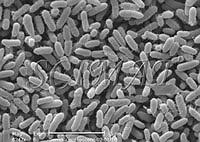 |
 |
| Bar: 5 µm | Bar: 5 µm |
 |
 |
| Bar: 5 µm | Bar: 5 µm |
Serratia marcescens is a common microbe which lives in soil, water, on plants, and in animals. Because of its bright red color and because it may grow on bread and communion wafers stored in a damp place, it has contributed to some interesting "miracles". In the images above the bacteria are shown captured on a bacterial filter as photographed under a scanning electron microscope (left) whereas the micrograph at right shows them in false colours as they grew on a soda cracker. These bacteria were considered for many years to be non-pathogenic. Because of their red pigment, they were used to trace bacterial transmission. In a study called "Operation Sea-Spray", the US Army filled balloons with S. marcescens and burst them over San Francisco in 1951 and 1952. A severe incidence of pneumonia and urinary tract infections followed shortly afterwards - and the bacterium has not been considered harmless anymore. Several S. marcescens sites bring additional information on this red bacterium. The images above are protected by copyright. For technical and scientific information about the images please contact the author. Commercial interest in micrographs should be directed to photo banks such as CMSP, MS, PR, PTUSA, etc. |
| Updated: May 18,
2007
©SCIMAT 2007 |